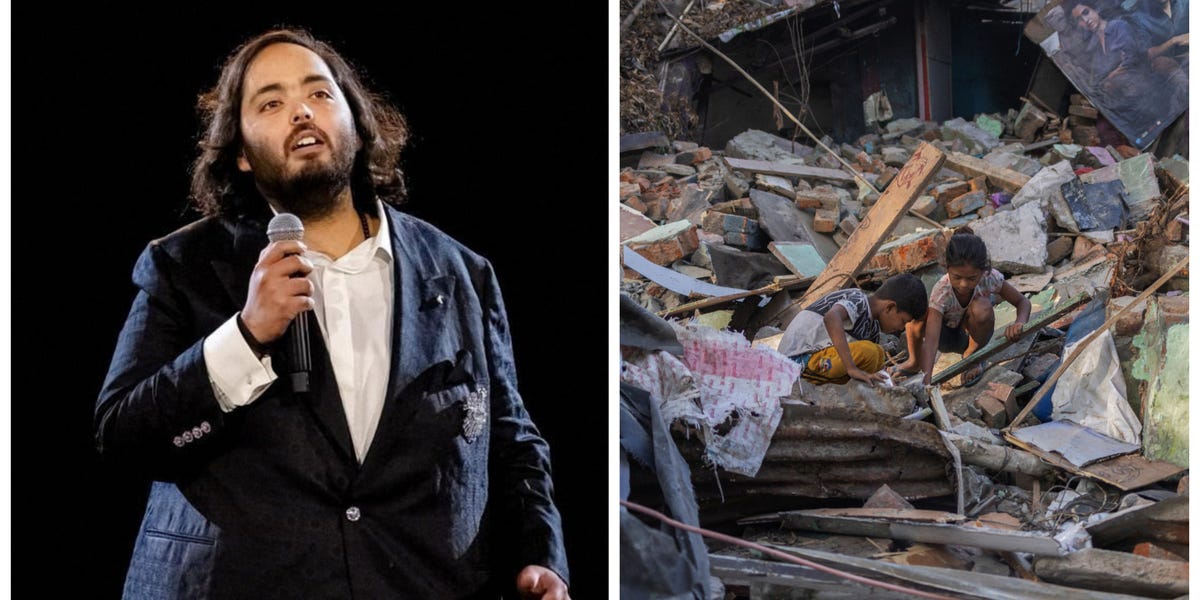- The pre-wedding festivities for Anant Ambani and Radhika Merchant cost many millions of dollars.
- Critics say the big spending highlights the wealth disparity in India, where many live in poverty.
- One Indian activist told BI the pre-nuptials showed a lack of empathy for impoverished Indians.
Thanks for signing up!
Access your favorite topics in a personalized feed while you’re on the go.
download the app

The lavish pre-wedding festivities for Anant Ambani, the son of Asia’s richest person, and Radhika Merchant, also the child of a billionaire, made headlines worldwide for their extravagance.
But critics say it showed a telling disregard for the struggles of the many millions of Indians living in poverty.
Spanning three days, the pre-nuptial event included a private performance by Rihanna, which estimates suggest cost up to $9 million. There was a trail featuring live animals and a nine-page dress code.
The mother of the groom-to-be, Nita Ambani, wore a necklace worth valued at some $60 million, which Business Insider noted was perhaps one of the biggest shows of wealth.
Almost half of the 1.4 billion people in India live below the median poverty line of $3.65 a day, per the World Bank, and activists say the ostentatious displays of wealth are an affront to the country’s poor.
‘It feels unfair’
“There is so much poverty all around,” said Shyam Bihari, a Delhi fruit seller and social worker, in a conversation with BI.
“It feels unfair to see this amount of money being spent on a wedding when so many people are still unable to access basic necessities like food and water,” he said.
Large swathes of India’s population have long grappled with food insecurity and water scarcity.
According to the World Food Programme, a quarter of the world’s undernourished people live in India. WaterAid says that around 35 million Indians lack access to safe water.
Rajni Haldia, a Delhi-based cleaner who earns $25 a month, told BI that she felt “very bad” watching the coverage of the lavish pre-wedding festivities while knowing the extent of poverty in India.
Haldia said: “I hope all the rich people who came to India for the wedding are seeing the difference between the rich and poor, and I hope the government can do more to tackle this.”
Rakhi Tripathi, a peace activist and associate professor at New Delhi’s FORE School of Management, told BI that the extravagant celebrations show a “disconnect” between India’s elite and the rest of the population.
Tripathi pointed out that 800 million of India’s 1.4 billion population receive monthly food rations of wheat or rice.
She said: “In a country like this, when we have such a huge event, spending crores of rupees, yeah, lack of empathy is the correct word.”
(Crore is an Indian term for 10 million; 1 crore rupees is around $120,000.)
Sohini Kar, an associate professor at the London School of Economics, whose work focuses on urban India, told BI she agrees.
“I certainly think there’s a lack of empathy, awareness,” she said.
(A representative for the Ambanis did not immediately respond to a request for comment from BI.)
Kar also said the festivities were emblematic of the troubling levels of wealth disparity in India.
According to Oxfam International, the top 10% of the Indian population holds 77% of the total national wealth.
In the US, the St Louis Fed says the figure is 66.6%.
The groom-to-be’s father, Mukesh Ambani, has an estimated net worth of $113 billion, making him the richest person in Asia and the 11th richest person globally, per the Bloomberg Billionaires Index.
Kar noted that the family is known in India for its extravagance, and lives in a skyscraper.
She said: “Their house itself in Mumbai is a stark reminder of the kind of disparity of wealth, where you can sort of visually see this massive house for one family over the slums around their area.”
According to Architectural Digest India, the 27-story property cost an estimated $1 billion to build. It towers over Mumbai’s Golibar slum.
In 2011, Ratan Tata, another of India’s richest men, told The Times of India: “It’s sad because this country needs people to allocate some of their enormous wealth to finding ways of mitigating the hardship that people have.”
The Ambani family does donate to charitable efforts through the Reliance Foundation. That body, founded by Nita and Mukesh Ambani, is one of the largest nonprofits in the country.
Anant Ambani and Radhika Merchant serve traditional Gujarati food to villagers ahead of their pre-wedding celebrations on the outskirts of Jamnagar, India.
Reuters/Stringer
The wedding also featured a communal dinner that fed some 51,000 local residents in Gujarat, The Hindu reported.
But, still, Kar suggested that the tens of millions spent on the festivities could have been spent on charitable initiatives, like addressing child malnutrition.
She said: “The amount of spending they had on one event could certainly go toward a much larger program for that kind of thing.”


